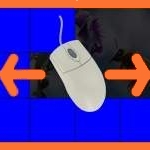
 |
Mouse Movement |
This activity is designed for learning the very basics of simple mouse control. It is a great introduction for children who are just beginning to use a mouse and are gaining confidence with the associated skills. The objective of the activity is for the child to move the mouse in a controlled, steady manner.
On entering the game children will see twelve blue squares arranged in a 4X3 grid. The pointer appears as a white arrow.
The object of the game is simply to move the pointer over the blue squares on the screen. The act of the pointer touching the squares will remove them and reveal part of a larger picture. There is no need for children to click the mouse button and at this stage they should be discouraged from doing so.
When all of the squares have been removed the picture will brighten and applause will sound. After a few seconds the next puzzle will appear.
The puzzle squares will become smaller and more in number. Some children will try to click the mouse buttons, so just explain to them that they don't need to. For children where this is a first experience with the mouse, the clicking concept can distract from what is happening on the screen.
To exit the game, click on the open hand on the red sign in the bottom right hand corner.
NOTE: This game will not operate correctly using the touch screen. The object of the game is to move the mouse arrow. This can only be done by using a mouse. Using a touch screen is the equivalent of moving and clicking. This is the only JuniorWiz game that must use a mouse to operate correctly.
Outcome 4: Children are involved and confident learners
Outcome 5: Children are effective communicators
Basic mouse movement
Hand-eye coordination
Concentration
Observation skills
Ask children to gently spread the fingers of their hand like a star and then place it on top of the mouse. The rounded part of the mouse should fit into the palm of their hand and the cord extend away from them. Their thumb should rest on the left side of the mouse, index finger on the left button, middle finger on the right button, and remaining two fingers grip the right side of the mouse.

Younger children with small hands will probably not be able to extend their thumb and little fingers to either sides of the mouse, so start with placing the index and middle fingers first and rest the others where comfortable. It is important that the hand placed on the mouse is relaxed with no fingers curled under or into the palm. The mouse should be held in front of the body and to the appropriate side. For example, right-handers will hold the mouse off to the right side of the body.